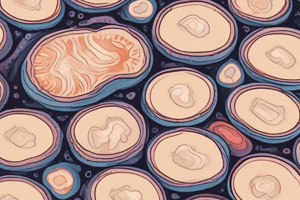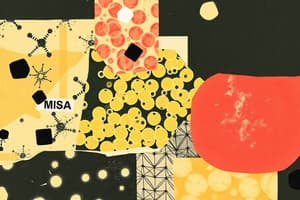Podcast
Questions and Answers
What causes the agar to turn from dull pink to bright pink in the presence of lactose-fermenting organisms?
What causes the agar to turn from dull pink to bright pink in the presence of lactose-fermenting organisms?
- Decrease in pH due to acid diffusion (correct)
- Interaction with Gram-positive organisms
- Introduction of bile salts
- Presence of crystal violet stain
What is the appearance of a non-lactose fermenter on MacConkey agar?
What is the appearance of a non-lactose fermenter on MacConkey agar?
- Yellow color change
- Bright pink precipitate
- Transparent growth
- Simple growth without color change (correct)
How do crystal violet stain and bile salts in MacConkey agar prevent the growth of unwanted organisms?
How do crystal violet stain and bile salts in MacConkey agar prevent the growth of unwanted organisms?
- By promoting the growth of lactose-fermenting organisms
- By creating an acidic environment
- By inhibiting Gram-positive organisms (correct)
- By inhibiting Gram-negative organisms
Which organisms are capable of surviving in MacConkey agar due to the presence of crystal violet and bile salts?
Which organisms are capable of surviving in MacConkey agar due to the presence of crystal violet and bile salts?
In what part of the digestive tract are E. coli and S. typhimurium naturally found?
In what part of the digestive tract are E. coli and S. typhimurium naturally found?
What property of MacConkey agar makes it a selective medium for certain organisms?
What property of MacConkey agar makes it a selective medium for certain organisms?
What is the purpose of MacConkey agar in the lab?
What is the purpose of MacConkey agar in the lab?
What metabolic capability is MacConkey agar able to identify?
What metabolic capability is MacConkey agar able to identify?
Why is lactose included in MacConkey agar?
Why is lactose included in MacConkey agar?
What happens when a bacterium ferments lactose on MacConkey agar?
What happens when a bacterium ferments lactose on MacConkey agar?
Which bacteria does MacConkey agar specifically target for growth and differentiation?
Which bacteria does MacConkey agar specifically target for growth and differentiation?
What role does the pH indicator play in MacConkey agar?
What role does the pH indicator play in MacConkey agar?
Flashcards are hidden until you start studying
Study Notes
Selective and Differential Media
- Selective and differential media are essential tools in a medical microbiology lab, used to identify unknown organisms.
- These media contain ingredients that select for specific types of organisms (e.g., Gram-positive or Gram-negative) and differentiate among them based on their metabolic capabilities.
MacConkey Agar
- MacConkey agar is a selective and differential medium that specifically selects for and promotes the growth of Gram-negative rods, particularly those from the Enterobacteriaceae family (enteric bacteria).
- These organisms are found in the intestinal tract.
- MacConkey agar contains lactose, a sugar that some organisms can ferment, while others cannot.
- The presence of lactose makes the media differential, as it allows for the differentiation of organisms based on their ability to ferment lactose.
- A pH indicator is added to MacConkey agar plates to visualize the differentiation through a color change.
- When lactose fermentation occurs, acid is produced, reducing the pH of the surrounding agar, and causing the pH indicator to turn from dull pink to bright pink.
- Organisms capable of lactose fermentation will be surrounded by a bright pink precipitate after incubation.
- MacConkey agar contains two ingredients to prevent the growth of unwanted organisms: crystal violet stain and bile salts.
- These ingredients inhibit the growth of Gram-positive organisms, making MacConkey agar selective.
- Organisms like E. coli and S. typhimurium can survive in the presence of crystal violet and bile salts, as they are naturally found in the digestive tract where they encounter bile salts.
Studying That Suits You
Use AI to generate personalized quizzes and flashcards to suit your learning preferences.




